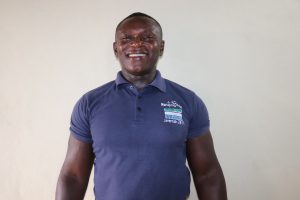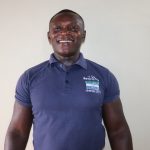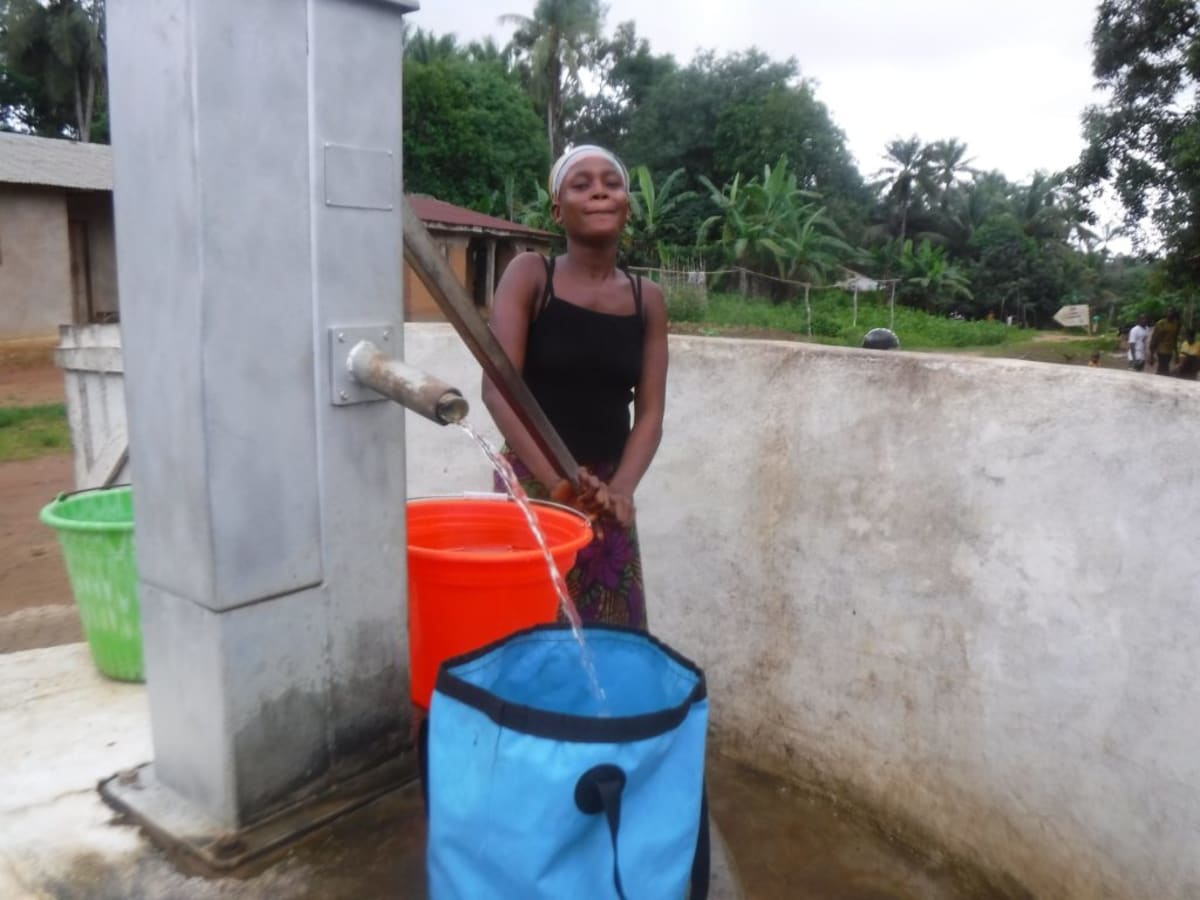October, 2022: Magbansor Community Well Rehabilitation Complete!
We are excited to share that a safe, reliable water point at Magbansor in Sierra Leone is now providing clean water to neighboring community members! We also conducted hygiene and sanitation training, which focused on healthy practices such as handwashing and using latrines.
"I used to fetch water from the swamp," said 14-year-old Fatima M. "The distance from my house to the swamp is far, and it is difficult to walk through. Sometimes I became fatigued and could not be strong to do other work at home after I had finished fetching water from the swamp."

Fatima pours water at the community celebration.
"Although the swamp water is not safe for drinking, I still [drank] from it," Fatima continued. "The water would be muddy sometimes, and that made it difficult to drink. Likewise, going to the stream, especially in the evening hours, made me to be afraid because of the bushes on the path to the stream. Wild animals [could] easily hide in these areas without my knowledge. I am happy that there is now [a] water well in this village. I will now drink clean water, and I will not be afraid to fetch water from this pump because it is in a good position.

Fatima pumps water from the rehabilitated well.
"Water will be always available at home," Fatima continued. "The pump water is clean, and I can fetch water from it to drink. Drinking [this water] will enable me to live a healthy life. Therefore, the new waterpoint will reduce the entire burden I used to face, and it will also influence my health positively. All the waterborne sicknesses I used to experience will now become history."
"Initially, we had no good water to drink in this village," said 40-year-old community headman Abdulai Bangura, who was also elected as the chairperson of the new water user committee. "I used to drink from the swamp water. Honestly, the water from the swamp is not clean. It sometimes [had an] unfavorable smell, but since I had no choice, I just [had to] drink from this source. There [were] times I [would] be suffering from terrible stomach pain due to drinking contaminated water.

Abdulai pours water at the celebration.
"Similarly, the walking distance was a big problem for me," Abdulai continued. "Walking [a] far distance to fetch water [made] it difficult to do multiple trips a day. By the time I made two trips, I [would] already be exhausted to carry on fetching water. Therefore, I am grateful to the organization for the new waterpoint. Having this new waterpoint will reduce all the water constraints I used to face.

Abdulai stands behind kids splashing at the well.
"Now that I have [a] water well in this village, I can get enough water at my house to cook, bathe, drink and do other domestic work. The new water point will make it easier for water to be always available at home because the distance is closer to my house. As a result, my wife will be able to cook in the morning hours before I go to the farm, and I will already meet the evening meal prepared. All these works can be done with ease due to the availability of water. That is why water is life: because it is needed for all day-to-day activities."

District Councilor Abubakarr Bangura splashes water with community members.
We held a dedication ceremony to officially hand over the well to the community members. Several local dignitaries attended the ceremony, including representatives from the Port Loko District Council, the Ward Council, and the Ministry of Water Resources. Each official gave a short speech thanking everyone who contributed to the rehabilitation of the water project and reminding everyone to take good care of it. Then, Fatima and Abdulai made statements on their community's behalf. The ceremony concluded with celebration, singing, and dancing.

Community members sing and dance at the dedication ceremony.
Clean Water Restored
The drill team arrived the day before beginning work. They set up camp and unpacked all their tools and supplies to prepare for drilling the next day. The community provided space for the team to store their belongings and meals for the duration of their stay. The following day, the work began.

First, we raised the tripod, the structure we use to hold and maneuver each drilling tool. Next, we measured the well's original depth. We then socketed the pipes and installed a casing.
Finally, we lined up the drill rods and started to drill! We reached a final depth of 19 meters with water at 13 meters. The hand-drill method allowed the team to install the cylinder far below the aquifer so that the community has excellent water access throughout the year.
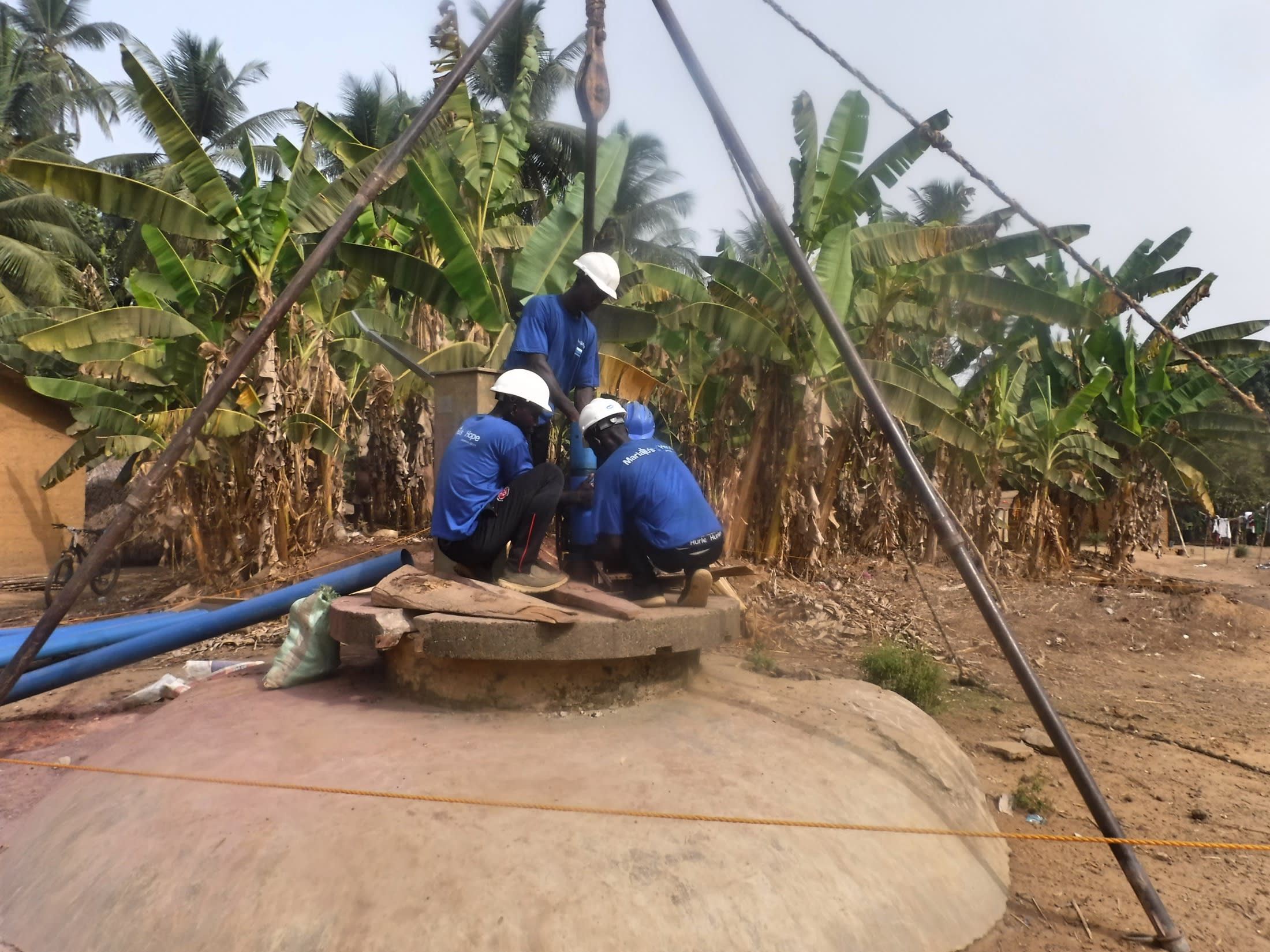
With drilling complete, we installed screening and a filter pack to keep out debris when the water is pumped. We then cemented an iron rod to the well lining and fixed it with an iron collar at the top.
Next, we bailed the well by hand for three days and flushed it, clearing any debris generated by the drilling process. Finally, we tested the yield to ensure the well would provide clean water with minimal effort at the pump.

Yield test.
As the project neared completion, we built a new cement platform, walls, and drainage system around the well to seal it off from surface-level contaminants. The drainage system helps to redirect runoff and spilled water to help avoid standing water at the well, which can be uncomfortable and unhygienic and a breeding ground for disease-carrying mosquitoes.
At last, we installed the pump and conducted a water quality test. The test results showed that this was clean water fit for drinking!

New Knowledge
Before conducting any hygiene training, we called and visited the local water user committee to understand the community’s challenges and lack of sanitation facilities. We shared the findings from our discussions with the committee members to help them make the necessary adjustments before the training began. For example, we identified households without handwashing stations or ones that may need to repair their latrines. With this information, community members worked together to improve hygiene and sanitation at home.
After this preparatory period, we scheduled a time when members from each household using the water point could attend a three-day hygiene and sanitation training. We then dispatched our teams to the agreed-upon location to hold the meeting.

Training topics covered included handwashing and tippy taps, good and bad hygiene habits, disease transmission and prevention, COVID-19, worms and parasites, dental hygiene, proper care of the well's pump, keeping the water clean, the cost recovery system, dish racks and clotheslines, the importance of toilets, keeping latrines clean, balanced diets, the diarrhea doll, and HIV and AIDS.

One of the most enlightening topics for the people of Magbansor was handwashing. Facilitators asked the community members to demonstrate how they usually wash their hands. The three demonstrators fetched a bowl of water, and each took turns dipping their hands in the water, then wiped their hands dry on their clothes. They were surprised to hear that this method wouldn't do much to protect them. Facilitators then displayed the proper method, which calls for running water, soap, and scrubbing. As participants left the training for the day, they could be heard asking each other whether anyone had heard that handwashing could protect them from diseases.

A facilitator shows models of a centipede and hookworm.
Another topic that sparked a lot of interest was worms and parasites, which are a significant issue in Sierra Leone and other tropical regions. However, not one of the training participants could accurately identify the causes of worm and parasite infections. One woman said she had always been told that people can get worms from fish and palm nuts. We explained that the most common pests will pass through contaminated food or water (like the swamp water Magbansor's people were drinking!) and also through walking barefoot on soil. The community members promised to stop walking barefoot and to give their children deworming medicine every three months.

Community members discuss how diseases spread by trying to put some infection illustrations in order.
"The training is valuable to me because this new knowledge will help to keep my life healthy," said headman Abdulai, whom we quoted earlier. "Before this training, I lacked [knowledge about] proper handwashing techniques, the value of dishracks, [and] the importance of having and using latrines. The other area I admired so much was how human beings can get worms. I was thinking that we [could] get worms through the food we eat, but with the training, I now know that we can get worms through walking barefooted and the dangers of worms. I will make sure I put all the good hygiene [measures] into practice."
As the community headman, Abdulai also said he would put penalties in place for anyone who fails to follow the practices outlined in the training since bad hygiene can affect a whole community and not just a household.
Conclusion
This project required a substantial collaboration between our staff, our in-country teams, and the community members themselves. When an issue arises concerning the well, community members are equipped with the necessary skills to rectify the problem and ensure the water point works appropriately. However, if the issue is beyond their capabilities, they can contact their local field officers to assist them.
Also, we will continue to offer them unmatchable support as a part of our monitoring and maintenance program. We walk with each community, problem-solving together when they face challenges with functionality, seasonality, or water quality. Together, all these components help us strive for enduring access to reliable, clean, and safe water for this community.
With your contribution, one more piece has been added to a large puzzle of water projects. In our target areas, we’re working toward complete coverage of reliable, maintained water sources within a 30-minute round trip for each community, household, school, and health center. With this in mind, search through our upcoming projects to see which community you can help next!
Thank you for making all of this possible!

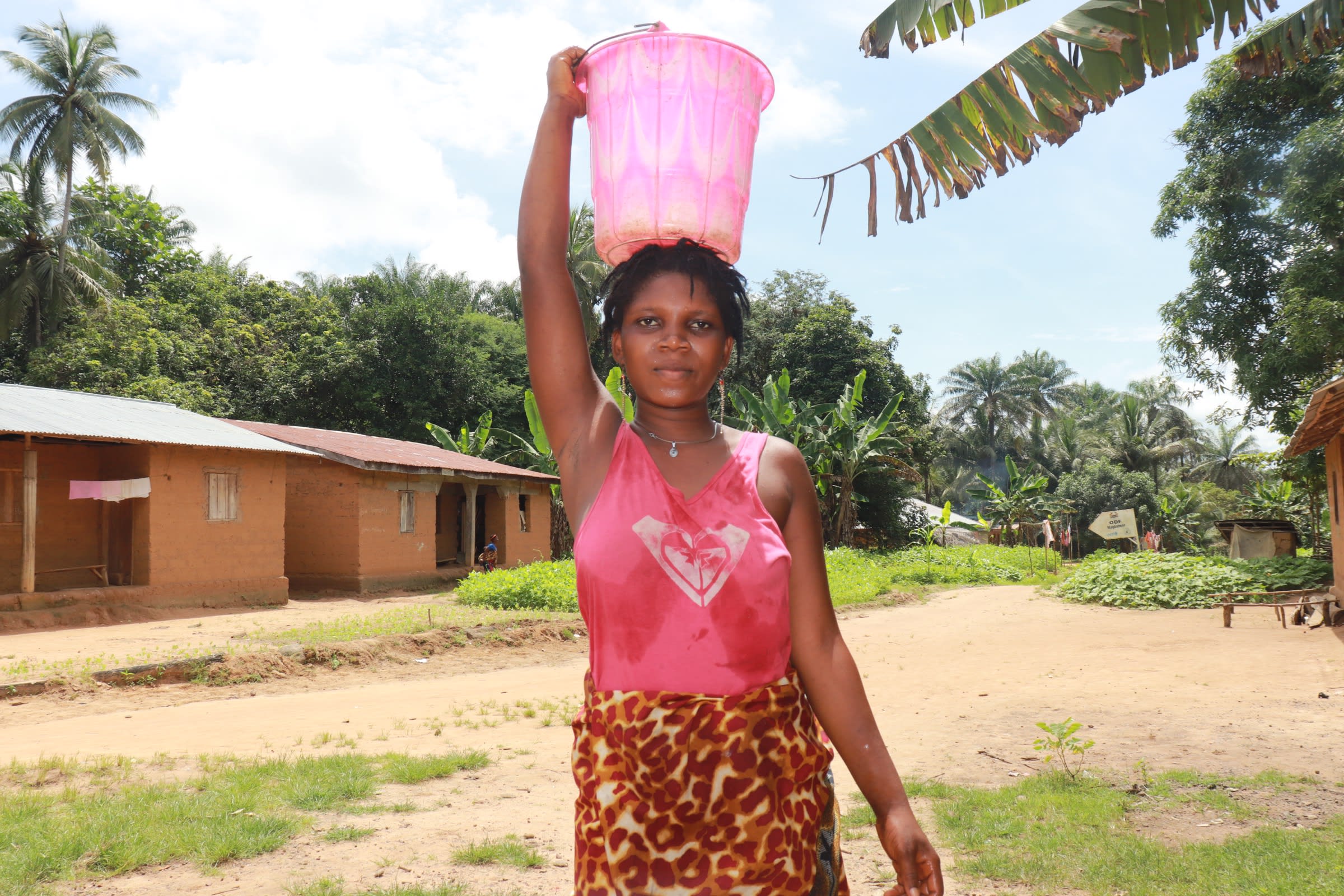
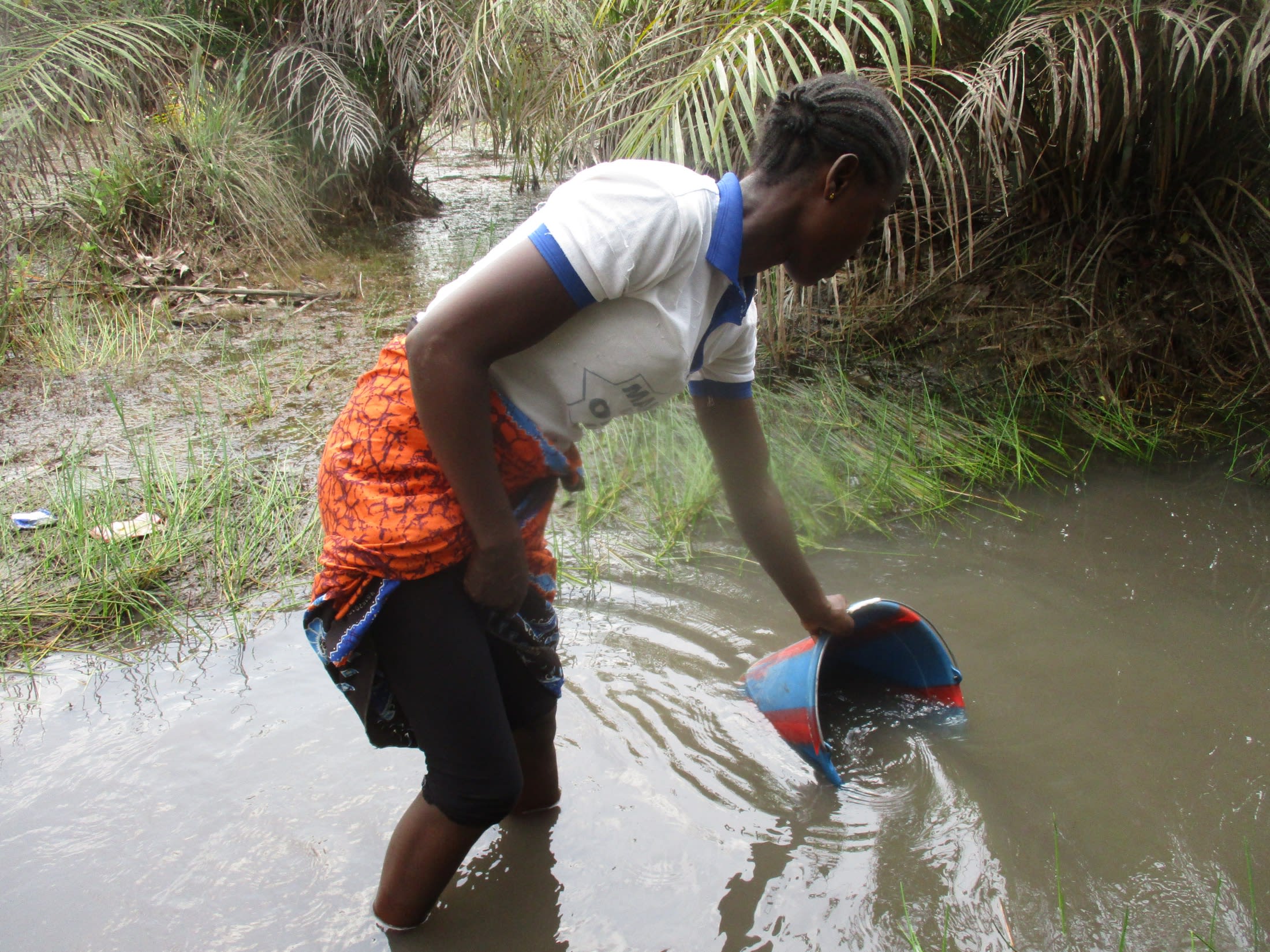

 Borehole Well and Hand Pump
Borehole Well and Hand Pump









